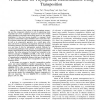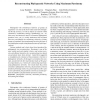20 search results - page 1 / 4 » A Heuristic for Phylogenetic Reconstruction Using Transposit... |
BIBE
2007
IEEE
13 years 11 months ago
2007
IEEE
Abstract—Because of the advent of high-throughput sequencing and the consequent reduction in cost of sequencing, many organisms have been completely sequenced and most of their g...
BMCBI
2008
13 years 5 months ago
2008
Background: Due to recent progress in genome sequencing, more and more data for phylogenetic reconstruction based on rearrangement distances between genomes become available. Howe...
CIBCB
2007
IEEE
13 years 11 months ago
2007
IEEE
— Rearrangements of genes and other syntenic blocks have become a topic of intensive study by phylogenists, comparative genomicists, and computational biologists: they are a feat...
CSB
2005
IEEE
13 years 10 months ago
2005
IEEE
Phylogenies—the evolutionary histories of groups of organisms—are one of the most widely used tools throughout the life sciences, as well as objects of research within systema...
WABI
2004
Springer
13 years 10 months ago
2004
Springer
Computational heuristics are the primary methods for reconstruction of phylogenetic trees on large datasets. Most large-scale phylogenetic analyses produce numerous trees that are ...


